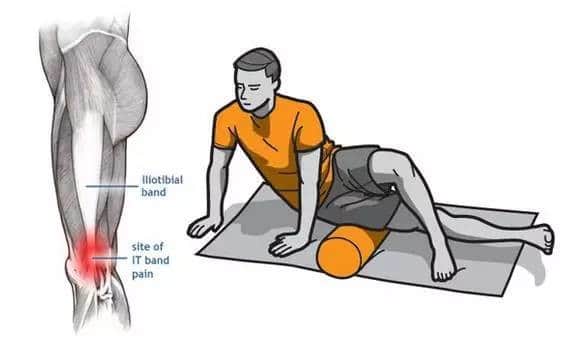Runner’s knee, often called patellofemoral pain syndrome (PFPS), is a common condition where people, usually runners or athletes, experience pain beneath the patella or at the front of the knee. Runner who have had it know that it can put a serious damper on training, and those who haven’t had it are well aware that it is something to avoid. When you know more about knee anatomy and runner’s knee treatment, you will be better equipped to prevent this issue and to treat it if you have it.
What is Runner’s Knee? What Causes It?
Patellofemoral pain syndrome is defined as knee pain at the front of the joint. It might feel similar to knee bursitis, in which the bursa, or fluid-filled sac under the joint, becomes painful and inflamed. Often, both knee bursitis and PFPS are caused by overuse injuries. Since running involves not only repeated flexion and extension of the knee, but also repeated impact, it is a common cause of knee injury and kneecap pain.
However, while running is a common cause (hence the name “runner’s knee”), there are other causes of patellofemoral pain syndrome. These can include acute injuries (like a kneecap injury), being overweight, or different physical changes beneath the kneecap. Additionally, patellar tracking disorder, a problem where the kneecap is not properly aligned, can also be a cause.
Because the knee anatomy is complex, it is important to understand that not everyone seeking knee pain relief is suffering from runner’s knee. Discussing symptoms with your doctor is important, and in some cases, imaging the knee joint can shed some light on what is happening.
What Are the Symptoms of Runner’s Knee?
Some people suffering from runner’s knee may just be complaining of a sore knee, but there are other, more specific symptoms that sometimes happen in those dealing with runner’s knee. In particular, you may notice that sitting with bent knees makes your knees sore, or that your kneecap pain intensifies when going down stairs or squatting.
Because runner’s knee involves the kneecap, those with this type of injury will frequently feel a grinding or grating sensation when walking, and the joint may also pop unexpectedly. Some people with this knee injury will also experience issues with joint buckling, when the knee joint will suddenly give way while walking. Some will find that the sore knee does not hurt all the time, while others may experience pain that is constant and severe.
How is Runner’s Knee Treated?
Before you panic and think that you will need a knee replacement, knee surgi, or other major procedure down the line, it is important to realize that there are many non-invasive treatments that can help resolve your pain and allow you to keep running pain-free.
The first line of treatment for runner’s knee is often physiotherapy. In this setting, your therapist may apply ice, use various manual therapy techniques, or even perform ultrasound therapy. In addition, a good portion of treatment is usually focused on stretching and various exercises to strengthen the musculature around the knee and correct ad imbalances.
Another form of pain management comes in the form of wearing a knee brace or wearing kinesio tape. A knee brace won’t fix the issue on its own, but it can provide relief while you and your doctor and/or physiotherapist work to correct underlying issues. A brace can help support the joint and stabilize the patella, and kinesio tape can do the same. the tape can provide a more customized fit, also it may relieve your pain by decrease pressure on tendon of the knee cap, in addition you may benefit from the support from proper taping.
here is a very informative video from Spidertech in regards to taping your knee.
If your physiotherapist has found that your runner’s knee is caused partially or totally by pronation, or a tilting of your feet, then custom-made orthotics can help correct the problem. These orthotics are molded to fit your foot and made specially to correct your existing pronation. They are made to fit inside your running shoes.
How Can I Prevent Runner’s Knee?
If you are not seeking runner’s knee treatment but want to avoid this painful and inconvenient injury, there are some things you can do to help. One is performing muscle strengthening exercises. many people have muscular imbalances than can influence the patella. For example, someone who is very quadriceps dominant may experience the quadriceps pulling harder on the patella than surrounding musculature. Thus, while strengthening surrounding muscles is important, so is stretching of the calves and quadriceps. Foam rolling is an excellent way to reduce excessive tightness.

Adjusting issues with your running form may be helpful as well. Getting a gait analysis can help you see points of your form, like your foot strike, that may eventually predispose you to injury. It may help to talk to a physical therapist or running coach if your gait analysis finds significant issues with form, as changing things like foot strike can be very difficult and will often take time.
This may sound obvious, but having the right running shoes is crucial for avoiding injury. Many runners keep the same shoes long after the cushion has been worn off, and this amplifies the stress of impact on the joints. If you are unsure of the right shoe for you, running store employees are generally very knowledgeable about fit and can help you find a shoe that can help educe your risk of injury.
In short, while runner’s knee is painful and inconvenient, being diagnosed with it does not mean the end of your running career, and there are ways to help prevent it as well. By staying vigilant about your risk factors and by visiting a knowledgeable physiotherapist if needed, chances are good that you will be able to keep running for many years without having to face the challenges that runner’s knee presents.
